Your cart is currently empty!
Author: admin
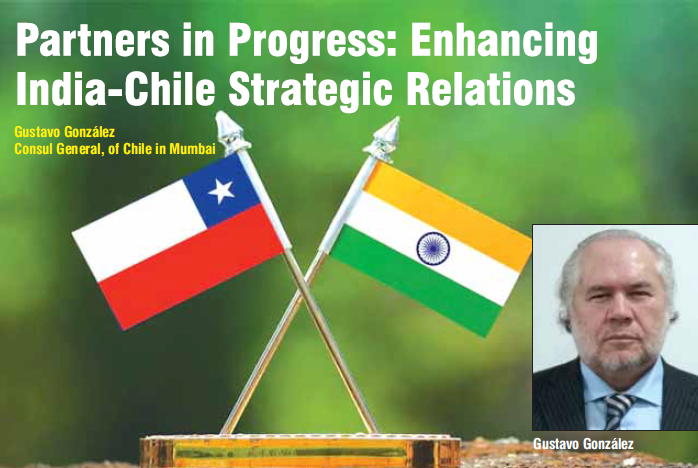
Partners in Progress: Enhancing India-Chile Strategic Relations
India and Chile maintain strong and friendly relations, sharing similar views on a variety of global issues. Chile aligns with India’s concerns regarding the threat of international terrorism and has consistently condemned the terrorism acts that India has faced. The two countries work closely together in multilateral forums and hold similar positions on climate change, renewable energy, and the expansion and reform of the United Nations Security Council (UNSC). Following Chile’s Foreign Minister’s official visit to India in April 2003, Chile expressed its support for India’s bid for a permanent seat on the UNSC, a position it has reiterated over the years.
India and Chile have signed various Agreements and Memoranda of Understanding (MoUs) to enhance cooperation in fields such as sports, science and technology, Antarctica, defense, air services, agriculture, new and renewable energy, education, outer space, geology and mineral resources, and the gainful employment of spouses and eligible dependents of diplomatic personnel. On September 6, 2016, an agreement was signed to expand the India-Chile Preferential Trade Agreement (PTA), increasing its coverage from approximately 474 tariff lines to 2,829 tariff lines. Further expansion of the PTA is currently under discussion. In April 2019, In April 2019, on the occasion of the official visit of the President of India, Ram Nath Kovind, agreements for cultural exchange and cooperation in the mining sector were renewed, along with a new agreement focused on cooperation in the disability sector. The Double Taxation Avoidance Agreement between India and Chile was signed on March 9, 2020, and came into effect on October 19, 2022, following ratification by both countries.
The dialogue between our countries has intensified, particularly evident in recent high-level meetings. During the recent encounter between Prime Minister Narendra Modi and Presidente Boric, at the G-20 Summit, both dignitaries underscored our shared ambition to deepen bilateral ties, especially in trade, investment, and cultural exchanges. We acknowledged the necessity to expand our Preferential Trade Agreement, which continues to offer significant potential given our robust trade, currently valued at $2.7 billion.
Is in this positive atmosphere that President Boric’s official visit to India, and this dynamic city, will take place next year. We are working to make this happen. President Boric stated that he and the Indian Head of State discussed the ongoing negotiations for a trade agreement between their two countries (CEPA) and explored new opportunities for investment and promoting public-private trade. Another significant aspect of their conversation focused on enhancing academic exchange and cultural collaboration. President Boric remarked, “India is one of the largest economies in the world, with immense demographic potential for the future. We are working to strengthen our ties, which we plan to deepen during our next official visit to India next year.” In response, Mr. Modi also shared on X that the two countries are reinforcing their relations across various sectors. He noted, “Our conversation highlighted how to deepen cooperation in the pharmaceutical, technology, and space sectors, among others. It is encouraging to see Ayurveda gaining popularity in Chile, which presents another area where our ties can flourish.” These statements provide a clear picture of the current and future state of Chile-India relations.
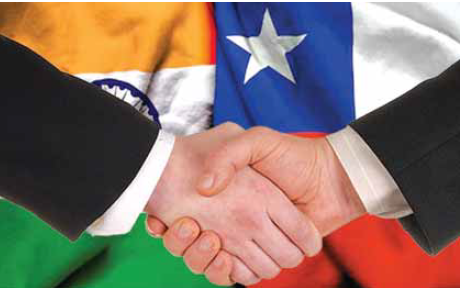
Additionally, two months ago, Chile’s Minister of Foreign Affairs, Alberto van Klaveren, visited India, marking his first visit to Mumbai. This visit occurred in the context of the Joint Commission Meeting (JCM) held in New Delhi on August 25-26, 2024. During this meeting, Chile reaffirmed its full support for India’s bid for a permanent seat in a reformed United Nations Security Council. Both governments expressed concern over the insufficient climate finance currently available for mitigation and adaptation, which fails to address the worsening impacts of climate change in developing countries. They emphasised the need for developed nations to mobilise additional climate finance to meet the targets outlined in the Paris Agreement. Moreover, in light of the vulnerability of their populations to the impacts of climate change, both countries, as members of the Coalition for Disaster Resilient Infrastructure (CDRI)—established in 2019 under the leadership of the Government of India—agreed to collaborate closely on building resilience against climate change. Disaster management emerged as a potential area for bilateral cooperation and exchange of experiences to effectively address the consequences of natural disasters such as tsunamis, earthquakes, floods, and other events.

At the trade level, there is a consensus that the current trade volume of $2.7 billion, while significant, is considerably below potential. One effective way to enhance our trade is by promoting mutual business partnerships, investments, and tourism. Both countries must explore mutually beneficial collaborations in the minerals sector, particularly in copper and lithium. Chile is already a key supplier of copper, but India seeks to secure long-term supplies with higher quantities due to the increasing demand for metals, such as copper, and minerals like lithium in the electric vehicle (EV) industry.

Chile’s vast reserves of essential minerals, especially lithium and copper, are of great interest to India. These minerals are crucial for India’s growing emphasis on electromobility and the manufacturing of electric vehicles. It is important to mention Chile’s national strategy for lithium, adopted last year, which invites Indian companies to participate in tenders for new lithium deposits. Collaboration in the lithium sector is expected to play a vital role in supporting India’s green energy initiatives. Agriculture remains another key area of cooperation between India and Chile, with a pressing need to expand the trade of agricultural products. Known for its abundant agricultural exports, Chile views India as a promising market for its products, particularly nuts, wines, and fruits. The two countries are working to address sanitary and phytosanitary (SPS) concerns to facilitate smoother trade. Chile has also expressed interest in importing Indian bananas, basmati rice, and mangoes. Additionally, India is exploring opportunities to export products such as roses, garlic, and kidney beans to Chile, aiming to diversify and enhance bilateral agricultural trade. To this end, both countries are diligently working to expedite the establishment of the Joint Working Group under the Memorandum of Understanding (MOU) for the Expansion of Cooperation in the Agriculture Sector, which was signed on May 16, 2023.
An important aspect of the bilateral trade between India and Chile is the potential for India to expand its presence in Chile’s pharmaceutical market. India is a leading global exporter of pharmaceutical products, and there is a growing demand for Indian medicines in Chile. There are significant opportunities for joint ventures between Indian and Chilean companies in this sector, which could further strengthen India’s foothold in the Chilean market. Such collaborations may also lead to the development of innovative healthcare solutions tailored to the needs of both countries. In this context, it is noteworthy that India seeks official recognition of Ayurveda, the ancient Indian system of health and well-being, in Chile.
Other vital areas for cooperation and investment include infrastructure, where Indian railway companies can provide ready-made rolling stock for Chilean railways and participate in developing railway projects in the country. In the defense sector, India’s industrial capabilities offer a wide range of solutions across various domains, including personal protective equipment, platform protection, electro-optics, high-end electronics and communication systems, arms and ammunition, artillery systems, armored vehicles, aircraft, aerial systems, naval ships and platforms, UAVs, and anti-drone technology.
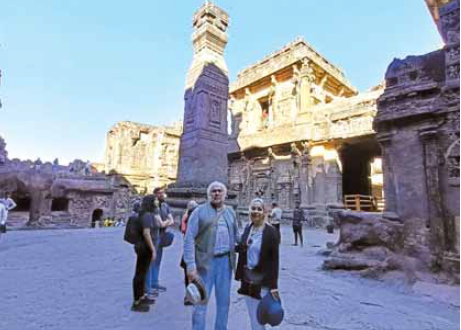
In education, science, space, and Antarctica, both countries are engaging in negotiations to finalise Memoranda of Understanding (MOUs) aimed at encouraging student mobility, promoting excellence in higher education, protecting the Antarctic environment—which is crucial for addressing climate change—and ensuring that the continent remains clear and safe. Additionally, both nations seek to collaborate in the peaceful use of outer space.
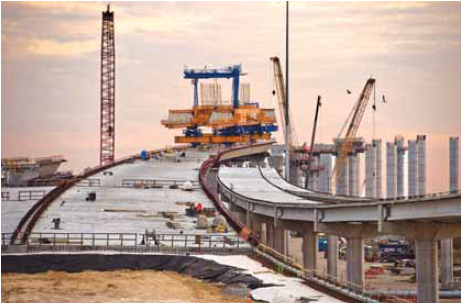
Chile remains a significant trade partner for India in Latin America, with bilateral trade reaching $2.7 billion in 2023-24. Beyond copper and lithium, Chile is also a key supplier of other critical exports to India. As both countries strive to enhance their economic ties, the potential Comprehensive Economic Partnership Agreement (CEPA) is expected to further strengthen their trade relationship.

In conclusion, India and Chile are at a watershed point in their bilateral relationship, distinguished by shared values, mutual respect, and a shared commitment to addressing global concerns. Their developing connection spans trade, climate resilience, education, renewable energy, and cultural exchange, demonstrating the breadth of their collaboration. With the promise of increased economic engagement through a Comprehensive Economic Partnership Agreement (CEPA), collaboration in critical sectors such as pharmaceuticals, agriculture, and critical minerals, and a shared vision for a sustainable and resilient future, the two countries are poised to strengthen their strategic ties. This alliance not only has the potential for mutual benefits, but it also reflects their shared commitment to promoting global peace, security, and development. As they prepare for high-level visits and additional discussions, the India-Chile alliance serves as a striking example of cooperation and the great potential of synergistic collaborations in our linked world.
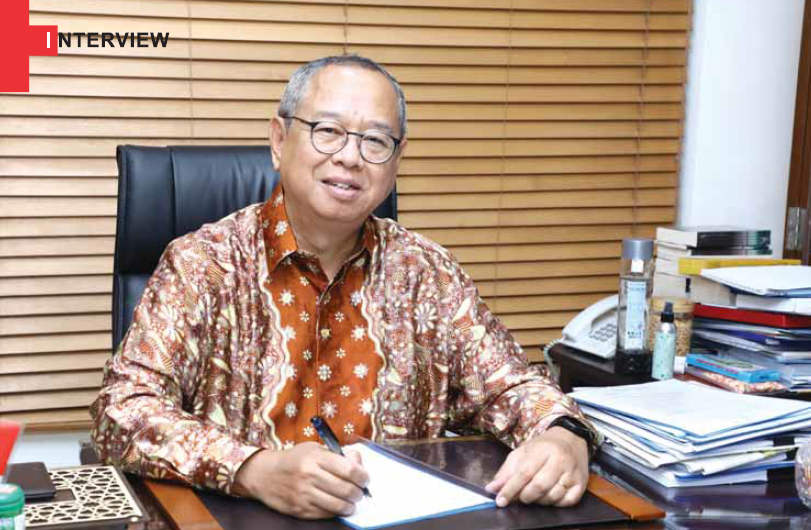
Strengthening Economic and Socio-Cultural Bonds Between Two Great Nations – Indonesia and India
Eddy Wardoyo is a highly respected diplomat who has served in various public service and international relations roles. Currently, he is holding the position of Consul General of the Republic of Indonesia in Mumbai, India. Throughout his career in the Indonesian diplomatic corps, he has gained valuable experience domestically and internationally. His passion for diplomacy comes from his genuine desire to promote global peace and understanding. Mr. Wardoyo is committed to further strengthening bilateral relations between Indonesia and India. Let us learn more about his mission through his conversation with Satya Swaroop, Managing Editor, Open Trade magazine.
What is your view on the recent spike in bilateral trade between India and Indonesia, especially given the significant increase in trade volume over the last several years?
The recent surge in bilateral trade between India and Indonesia is indeed a testament to the robust economic relationship between our two nations. This increase in trade volume reflects not only our shared commitment to fostering economic cooperation but also the immense potential for further growth and development in our trade relations. It is crucial to recognise that our economic ties are deeply rooted in the strong cultural and historical connections between India and Indonesia, which have existed since ancient times. Events such as India’s prompt recognition of Indonesia post-independence and our collaborative efforts in various international forums underscore the depth of our partnership. The India-Indonesia Comprehensive Economic Cooperation Agreement (CECA) signed in 2011 underscores our commitment to enhancing bilateral relations. Moving forward, we must continue to leverage these cultural and historical ties to drive sustained growth and prosperity in our bilateral trade relations.

How do you perceive your role in India, given the historical and cultural ties between our countries?
The historical and cultural ties between India and Indonesia are indeed significant. Dating back to Indonesia’s recognition by India shortly after its independence in 1947, our nations have shared a deep bond. India’s support during Indonesia’s early years of independence, including facilitating the first Asian conference in New Delhi in 1947, demonstrates the strength of our relationship. The President of the Republic of Indonesia Sukarno, and the Prime Minister of India Jawhar Lal Nehru were among the five founders of the Non Aligned Movement. Their collaboration during the NAM era highlights the mutual respect and cooperation that existed between our countries. As Consul General, I see it as my responsibility to further strengthen and nurture these ties, building upon the strong foundation laid by our predecessors.
India and Indonesia aim to achieve a $50 billion bilateral trade target by 2030. What are your thoughts on this?
The bilateral trade target of $50 billion by 2030 reflects the immense potential for economic cooperation between India and Indonesia. India’s expertise in sectors such as pharmaceuticals, digital technology, and infrastructure development complements Indonesia’s strengths in areas like agriculture, manufacturing, and natural resources. By leveraging each other’s strengths and exploring opportunities for investment and joint ventures, we can work towards achieving this ambitious trade target.
Are there any ongoing actions or agreements to make trade easier, hasten trade processes, and give businesses better access to markets in both countries?
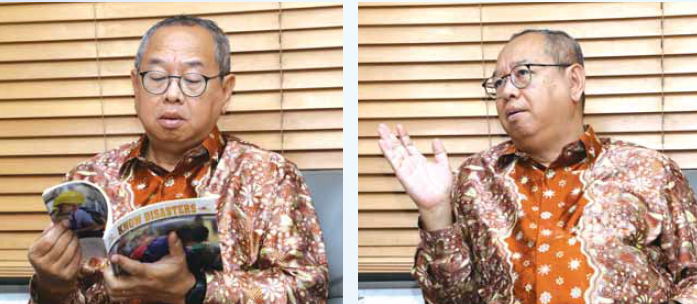
Certainly, there are ongoing efforts and agreements in place to simplify trade processes and improve market access for businesses in India and Indonesia. My consulate team and I are enthusiastic about organising various activities to advance this objective. One notable initiative is the proposal to hold events such as the “Jakarta Mumbai Update,” which will provide a platform for thorough discussions and collaborations across various sectors. These events not only encourage dialogue between stakeholders, but also offer valuable insights and opportunities for businesses to expand their reach and explore new markets. Furthermore, both countries are actively engaged in bilateral dialogues and negotiations to address trade barriers and create a more favourable environment for trade and investment. Through such initiatives, we are working towards simplifying trade, speeding up trade processes, and ultimately promoting greater economic integration between India and Indonesia.

Mumbai is the financial hub of the country as well as the city where Hindi cinema or Bollywood is based. Along with the proposed Jakarta Mumbai Update, it would be a
wonderful opportunity to host a small film festival which would contribute to cultural exchange between Indonesia and India.
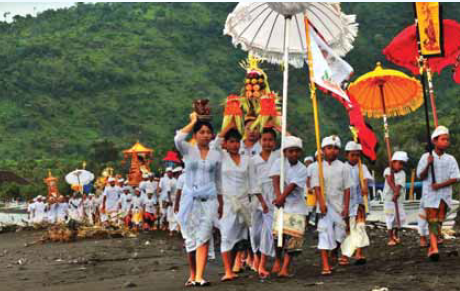
Indeed, film festivals offer an excellent platform for cultural exchange, and I appreciate the suggestion. It is true that while Indonesian audiences are familiar with Bollywood films, there is a lack of awareness about Indonesian cinema among Indian audiences. However, there is great potential for collaboration in this area. I recently encountered a cinephile in Goa who expressed a keen interest in Indonesian horror movies, praising their quality. This illustrates the untapped market for Indonesian cinema in India. Moreover, I believe promoting Indonesia as a filming destination can further strengthen ties between our countries. By facilitating meetings with India’s film industry, we hope to showcase Indonesia’s potential and foster collaboration in film production. Similarly, we acknowledge the opportunity to learn from India’s rich cinematic heritage and industry expertise. Ultimately, promoting cultural exchange through film can deepen mutual understanding and appreciation between our nations.

India and Indonesia have historical linkages dating back two millennia. Orissa or Odisha as it is now known
celebrates ‘Baliyatra’ or the ‘Voyage to Bali’ to commemorate the ancient maritime trade links between Odisha (India) with Indonesia and other Southeast Asian countires. How have these connections
influenced their current relations and cooperation?
The Bali Yatra holds immense historical and cultural significance for both our nations. This journey, from Paradip to Bali, represents not just a physical voyage but also a metaphorical one, signifying the enduring friendship and cultural exchange between our peoples.
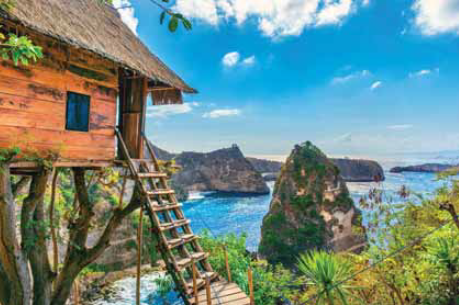
How do you view the significance of cultural ties like the Ramayana in promoting tourism between our countries?
Cultural landmarks, such as the Ram temple in Ayodhya, hold significant value as symbols of our shared heritage. The Ramayana, which is deeply ingrained in both Indian and Indonesian cultures, creates a bond that transcends borders. By promoting destinations associated with the Ramayana narrative, we can attract tourists from both countries and encourage them to understand and appreciate our shared cultural heritage better.
How do you feel about your time in Mumbai so far? My time in Mumbai has been incredibly rewarding. Mumbai’s vibrant culture, dynamic business environment, and warm hospitality have made me feel right at home. It truly invigorates me as a diplomat. I have had the pleasure of meeting a diverse array of individuals, many of whom are deeply enthusiastic about fostering robust collaborations. This optimism is what fuels my belief that Mumbai serves as an ideal hub for enhancing cooperation between our nations. I am excited about the potential for collaboration and partnership between Mumbai and Indonesia, and I look forward to further deepening our ties in the days ahead.
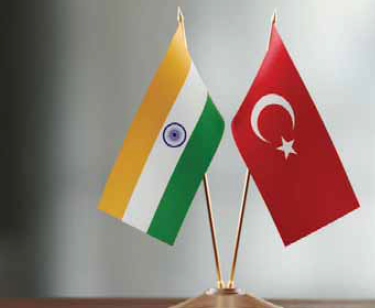
Benefits of Collaboration Between Indian and Turkish Companies in Global Markets
Collaboration between Indian and Turkish companies can offer numerous advantages in various global markets. These partnerships can create synergies that enhance competitiveness and market reach by leveraging each other’s strengths. Here are some of the key benefits.
Access to New Markets
Expanding Market Reach: Collaborations can provide Indian companies with easier access to markets in Europe, the Middle East, and Central Asia through our established trade networks and strategic location. Similarly, Turkish firms can gain access to South Asian markets through Indian partners.
Diversified Market Presence: By partnering, companies can diversify their market presence, reducing dependence on any single region and spreading risks across multiple markets.
Enhanced Competitiveness
Combined Expertise: Indian companies excel in IT, pharmaceuticals, and textiles, while Turkish firms are proficient in automotive, construction, and manufacturing. Combining this expertise can lead to innovative products and services that are more competitive globally.
Cost Efficiency: Joint ventures can optimise production processes and supply chains, reducing costs through shared resources and economies of scale.
Technology and Innovation
Technology Transfer: Partnerships can facilitate the transfer of technology and knowledge, helping both Indian and Turkish companies stay at the forefront of innovation. For instance, Indian IT firms can support Turkish manufacturing companies in digital transformation.
Research and Development: Joint R&D initiatives can lead to the development of new products and technologies, enhancing the competitive edge of both partners in global markets.
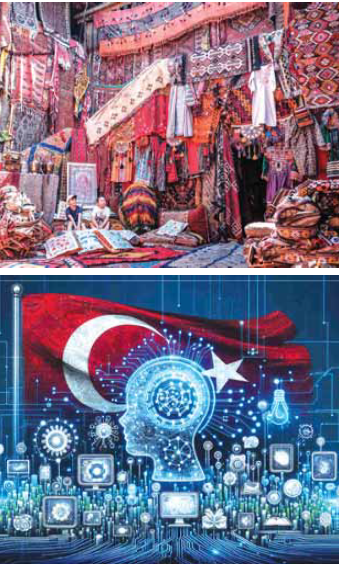
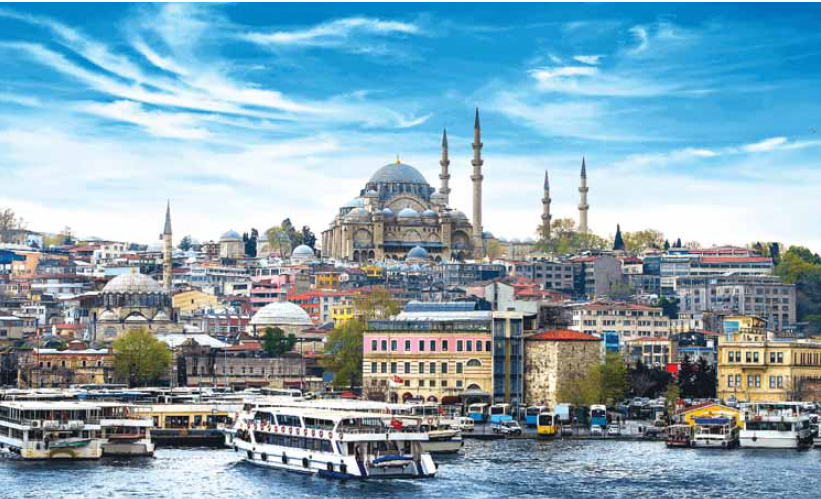
Cultural Synergy
Cultural Insights: Indian and Turkish companies can benefit from each other’s cultural insights and business practices, which can be crucial for effective market penetration and customer engagement in different regions.

Enhanced Customer Relations: Understanding and respecting cultural nuances can lead to better customer relationships and brand loyalty in diverse markets.

Operational Synergies
Optimised Supply Chains: Collaboration can streamline supply chains, thereby reducing lead times and improving efficiency. For example, Turkish companies’ proximity to European markets can be leveraged to expedite distribution.

Shared Infrastructure: The partnership can share infrastructure, including manufacturing facilities and distribution networks, thereby reducing capital expenditure and operational costs.
Government Incentives and Support
Leveraging Bilateral Agreements: India and Türkiye have various bilateral agreements that offer tax incentives, subsidies, and other benefits to collaborative ventures. Companies can take advantage of these to reduce costs and increase profitability.
Support Programmes: Both governments offer support programmes for joint ventures and foreign investments, providing financial assistance, grants, and other resources to foster collaboration.

Risk Mitigation
Shared Risks: Collaboration allows companies of both countries to share risks, particularly in volatile markets. Joint ventures can cushion the impact of economic downturns, regulatory changes, and other uncertainties.
Diversification: By entering new markets together, companies can diversify their portfolios, spreading risk across different geographies and industries.

Conclusion
Collaborations between Indian and Turkish companies can unlock significant benefits in global markets, from expanded market access and enhanced competitiveness to shared technology and cultural synergy. These partnerships can lead to innovative solutions, optimised operations, and better risk management. By leveraging each other’s strengths, Indian and Turkish firms can create a robust and dynamic presence in the global marketplace, driving mutual growth and success.
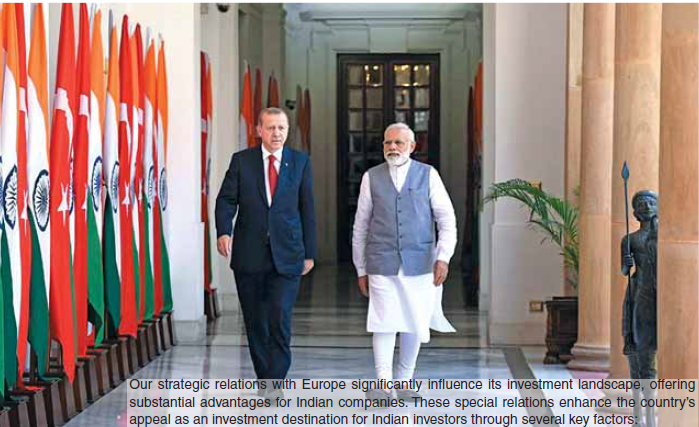
The Importance of Türkiye’s Special Relations with Europe for Indian Investors
Customs Union with the European Union
Since 1996, we have been part of a Customs Union with the European Union (EU), enabling the free movement of goods between us and EU Member States. This Agreement provides Indian companies investing with us direct access to one of the world’s largest and most affluent markets without facing customs duties or quantitative restrictions, thereby reducing the cost of exporting goods to Europe and enhancing the competitiveness of products manufactured in the country.
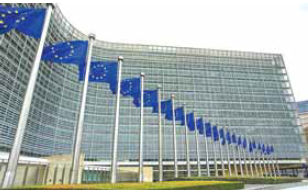
Trade Agreements and Market Access
We have established free trade agreements (FTAs) with numerous countries, including many in Europe, further facilitating market access for Indian companies. These Agreements enhance its position as a gateway to multiple markets, providing Indian investors with broader opportunities to expand their reach beyond the Turkish market.

Regulatory Alignment with the EU
Our regulatory framework, particularly in sectors like manufacturing, automotive, and pharmaceuticals, adheres to EU standards and regulations. This alignment ensures that the products manufactured in our country meet high-quality standards, making them more attractive to European consumers. For Indian companies, this means that investments in Türkiye can easily comply with stringent European requirements, simplifying the process of entering and succeeding in the European market.
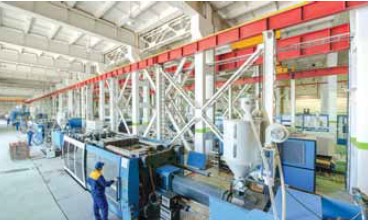

Strategic Partnerships and Joint Ventures
Our robust economic and trade relations with Europe have led to numerous strategic partnerships and joint ventures between Turkish and European companies. Indian firms can leverage these existing networks and collaborations to gain insights, share technologies, and enter the European market more effectively. These partnerships can provide valuable market intelligence and help navigate the complexities of the European business environment.
Investment Incentives and Support
We offer various incentives to attract foreign investment, including those from Indian companies. These incentives are often designed to enhance our role as a bridge to Europe, including tax breaks, subsidies, and support for research and development projects. Additionally, our Office provides comprehensive assistance to foreign investors, aiding them in navigating the regulatory environment and maximising the benefits of their investments.
Conclusion
Our special relations with Europe significantly enhance its appeal as an investment destination for Indian companies. The Customs Union with the EU, trade agreements, regulatory alignment, logistical advantages, strategic partnerships, and government incentives all contribute to creating a favorable investment environment. By leveraging these advantages, Indian companies can establish a strong presence in our country and use it as a strategic base to access and succeed in the European market. This synergy of our unique position and the opportunities we offer to Indian investors creates a mutually beneficial relationship.

Direct Investment Opportunities for Indian Companies in Türkiye
Türkiye, strategically positioned at the crossroads of Europe and Asia, offers a dynamic market and robust economy, making it a lucrative destination for Indian companies seeking direct investment opportunities. This article delves into the standout sectors for investment and highlights the factors that make Türkiye an attractive proposition for Indian enterprises.
Strategic Location and Economic Landscape
Türkiye’s unique geographic location serves as a bridge between Europe and Asia, granting access to key markets on both continents. With a large, youthful population, a burgeoning middle class, and a skilled workforce, our country is a magnet for foreign direct investment (FDI). Our diversified economy and strong industrial base further enhance its appeal, providing Indian companies with myriad opportunities to expand their global footprint.
Key Sectors for Investment
Automotive Industry
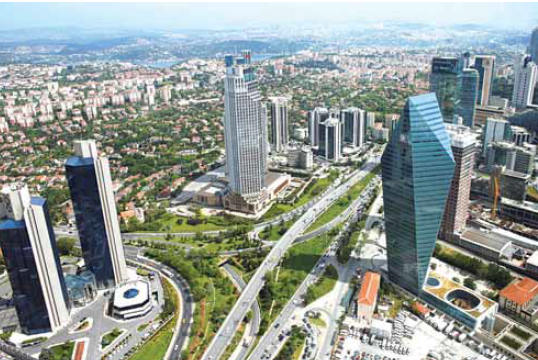
Türkiye’s automotive sector is among the most developed and rapidly expanding industries in the country. Boasting a well-established supply chain, significant production capacity, and robust export performance, this sector presents ample opportunities for Indian companies. Joint ventures and partnerships with Turkish manufacturers can offer Indian firms access to cutting-edge technologies and new markets.

Textiles and Apparel
As a major player in the global textiles and apparel market, ours proximity to European markets and high-quality production capabilities make it an attractive destination for Indian textile companies. Investments in this sector benefit from the country’s advanced infrastructure, skilled labour force, and strong export orientation.
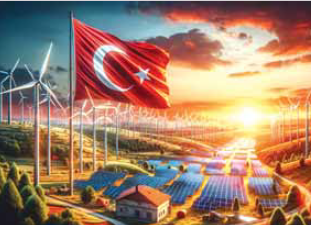
Renewable Energy
Driven by government incentives and a favorable regulatory environment, our renewable energy sector is experiencing significant growth. With abundant natural resources, including solar, wind, and geothermal energy, we offer excellent investment opportunities for Indian companies specialising in renewable energy technologies and services. Collaborations in this sector can contribute to sustainability goals for both nations.

Healthcare and Pharmaceuticals
We are currently modernising and expanding our healthcare sector, leading to a growing demand for pharmaceuticals, medical devices, and healthcare services. Indian pharmaceutical companies have the opportunity to engage in manufacturing, research and development, and distribution within Türkiye. Additionally, our country’s strategic location provides a gateway to neighbouring markets in the Middle East and Europe.

Investment Incentives and Support
We offer various incentives to attract foreign investment, such as tax exemptions, reduced tariffs, and financial support for research and development. Furthermore, our Investment Office provides comprehensive support to foreign investors, simplifying the process of establishing and expanding businesses in the country.

Conclusion
Our vibrant economy, strategic location, and diverse industrial landscape offer compelling investment opportunities for Indian companies. By capitalising on our strengths and exploring key sectors such as automotive, textiles, renewable energy, ICT, and healthcare, Indian firms can enhance their global presence and contribute to the economic growth of both countries. Through crucial partnerships and the right strategies, the future appears promising for Indian investments in Türkiye.
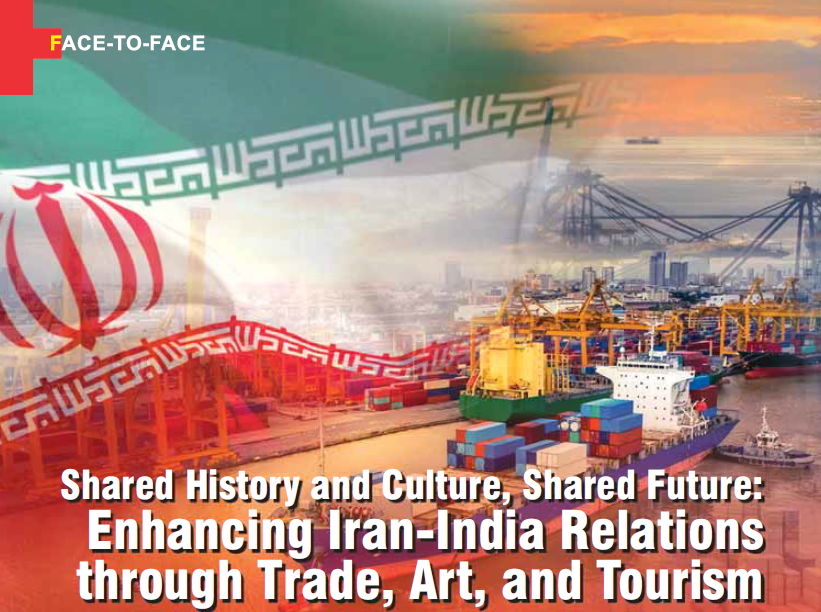
Shared History and Culture, Shared Future: Enhancing Iran-India Relations through Trade, Art, and Tourism

As the global landscape shifts, Iran and India are increasingly focused on strengthening their partnership and discovering new opportunities for collaboration. In a recent discussion between Davoud Rezaei Eskandari, the Acting Consul General of Iran to Mumbai, and Satya Swaroop, the Managing Director of Open Trade magazine. The conversation delves into how Iran’s rich cultural heritage and emerging tourism sector could act as a catalyst for strengthened economic and cultural ties, paving the way for more robust bilateral exchanges between the two nations. It also explores the multifaceted relationship between Iran and India, focusing on key areas such as trade, art, culture, and tourism.
As the global landscape shifts, Iran and India are increasingly focused on strengthening their partnership and discovering new opportunities for collaboration. In a recent discussion between Davoud Rezaei Eskandari, the Acting Consul General of Iran to Mumbai, and Satya Swaroop, the Managing Director of Open Trade magazine, we gain valuable insights into how Iran’s rich cultural heritage and emerging tourism sector could drive deeper economic and cultural ties between the two countries. This conversation explores the vibrant and personal aspects of the Iran-India relationship, touching on how trade, art, culture, and tourism can strengthen our connections and foster mutual growth. It is a look into how these rich and diverse elements bring the countries closer together and open new doors for collaboration.
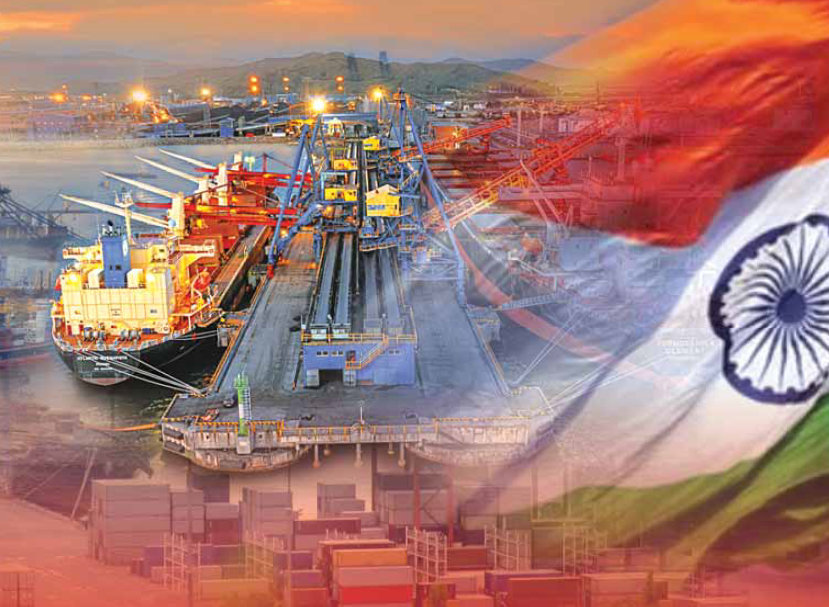
What are the economic and strategic implications of the Chabahar
Agreement?
The Chabahar Agreement, signed after eight years of discussions between Iran and India, is a ten-year deal of great economic and strategic importance for both sides. For India, it marks the first management of a foreign port, enhancing its connectivity to Afghanistan, Central Asia, the Caucasus, Russia and Europe via the International North–South Transport Corridor (INSTC). This route is significantly shorter and cheaper than the traditional route through the Suez Canal, reducing the distance from Mumbai to St. Petersburg by 30%. For Iran, Chabahar, as the only deep-sea port, is crucial for the development of the southeastern region and is part of a broader strategic plan. Surely, this agreement will strengthens not only India-Iran relations, but also will positively affect India’s global outreach.
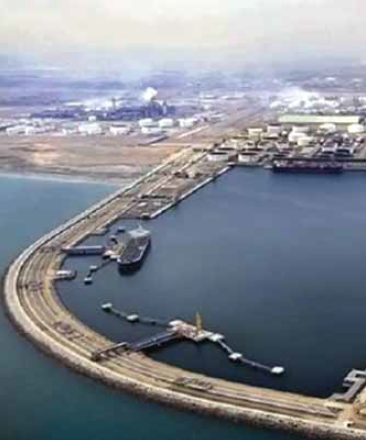
How does Iran’s geographical position enhance its connectivity and economic significance for India and other regions?
Iran’s strategic location serves as a vital link for landlocked countries like Azerbaijan, Armenia, Kazakhstan, Kyrgyzstan, Uzbekistan, Turkmenistan, and Tajikistan. Iran’s extensive railroads connect to Turkey, Central Asia, and Pakistan, facilitating efficient cargo transport. Additionally, travelers can now journey through Iran via regular railroad systems that connect to Turkey. Moreover, a direct shipping line from West India to Chabahar in Iran takes 3-4 days, offering a shorter, safer, and more cost-effective route for businesses. This enhanced connectivity benefits India and reinforces Iran’s role as a regional hub.
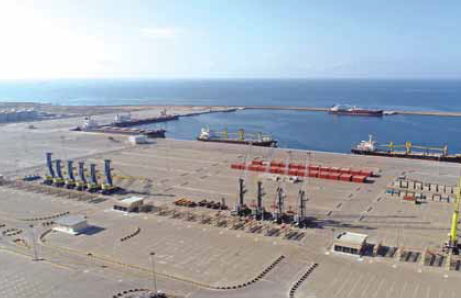
Have bottlenecks affecting the Chabahar project been
resolved, and will this
strengthen Iran-India relations?
Yes, recent challenges have been successfully addressed. The shipping line is now operational. India has committed $120 million to expand the capacity of the Chabahar port and offered a $250 million credit line to support regional development projects. These strategic initiatives are poised to bolster Indian trade and strengthen Iran-India bilateral relations. Leveraging Iran’s abundant energy and mineral resources and India’s burgeoning economy, this collaboration holds immense promise. Iran, with a population of 89 million and a half a trillion dollars GDP, presents billions of dollars lucrative investment prospects, including in energy, petrochemical, pharmaceutical, infrastructure, over 50,000 mine, etc.
What sectors will drive future cooperation between Iran and India?
Key sectors include oil and gas, where Iran had been a major supplier to India for many years, with many Indian refineries well optimized for Iranian oil. Additionally, the petrochemical industry, producing over 100 million tons annually, offers growth opportunities. Iran’s car manufacturing sector, producing over 1.3 million cars per year, also presents potential for collaboration. Pharmaceutical and agricultural sector are another scopes that deserve attention by Indian businessmen.
Are you focusing on electric vehicles (EVs) and what other sectors present opportunities for cooperation with India?
Yes, “Iran has recently entered the electric vehicle production sector through collaboration with Chinese companies. Despite the presence of established domestic car manufacturers like Iran Khodro and Saipa, there is a demand exceeding production capabilities, presenting opportunities for Indian companies as well. Additionally, the pharmaceutical sector offers potential for joint ventures, given that Iran produces 95% of its drugs domestically but still imports Active Pharmaceutical Ingredients (APIs), including from India. Iran could serve as a hub for both automotive and pharmaceutical industries, benefiting from its robust regional market access.
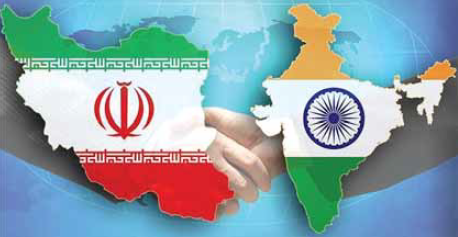
Beyond that, key sectors include oil and gas, petrochemicals, machinery, and agriculture. The existing trade includes Indian rice, tea, sugar, bananas, and mangoes, alongside Iranian apples, kiwis, and other fruits. Notably, there is significant untapped potential for collaboration in energy, as Iran’s abundant oil, gas, and chemicals will supply India’s growing demand for continuing its development.
Can you elaborate on Iran’s rich history and tourism
potential? What are some key
attractions?
Iran has been a key civilization alongside India, China, Egypt, Greece, and Roman Empire. The cultural and historical ties between India and Iran span millennia. Iran boasts an impressive collection of 29 UNESCO World Heritage sites, stunning landscapes, and diverse climates, ranging from arid deserts to scenic ski resorts. Among its notable cities include Shiraz, home to the ancient Persepolis with a history dating back over 2,000 years, and Isfahan, renowned for its 16th-century architectural marvels, Yazd with its magnificent historic architectures remain relatively undiscovered by many Indian travelers. Beyond its architectural and historical treasures, Iran features important religious sites in Mashhad and Qom, attracting Muslim pilgrims from all over the world.
Efforts are underway to introduce this hidden gems to Indian tourists. In February 2024, Iran took a significant step by waiving visas for Indian nationals, further enhancing accessibility for Indian tourists. However, there remains untapped potential in promoting the country’s diverse destinations, necessitating additional efforts.”
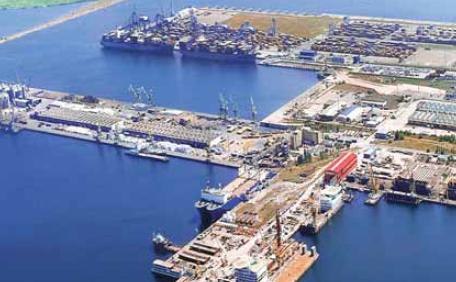
How is Iran promoting and empowering women entrepreneurs?
It’s important to note that during the last decades, very good progress has been made to promote the situation of women entrepreneurs in Iran. However, as in every other country, there is still significant room for improvement. Iran’s education system is dynamic, boasting 3.3 million university students and maintaining a nearly equal gender ratio in universities and women constitute nearly 50% of university students. Among around 80,000 university faculty members in Iran, 30% are women, and many others, hold active roles in media and business and in other sector of our society as well. Despite prevailing misconceptions, Iran is diverse and vibrant country, offering substantial opportunities for women across various sectors. For instance, a female professional I used to collaborate with a decade back in Brazil, initially had hesitation to visit Iran due to these preconceived notions. However, after a week-long trip, she was pleasantly surprised by the dynamic and active society, which defied her expectations, and I am sure it would be the case for anybody else who travel to Iran for the first time. Contrary to common portrayals, Iran is a dynamic, multifaceted and multicultural nation.
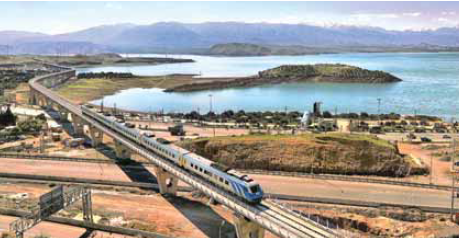
How did recent events impact the organization of the presidential election, and what measures were taken to ensure its smooth conduct?
Despite the temporary disruption caused by the recent helicopter crash, we efficiently orchestrated the presidential election within a span of less than two months. With over 344 polling stations abroad, with four of them located in India (Delhi, Hyderabad, Mumbai, and Pune). Through these measures, we have ensured a smooth electoral process, engaging both local councilors and Iranian expatriates.

How are sanctions affecting Iran?
Despite the existing sanctions, we have effectively managed our operations. We export over 3 million barrels of oil daily and import essential goods, despite challenges in banking and business with Indian companies. Our bilateral trade with India is nearly $5 billion, and last year’s total trade turnover of Iran surpassed $160 billion. Despite the US withdrew from the agreement, we remain open to negotiations and are ready for a resolution.
Can you share recent cultural events involving Iran?
We have organized several cultural events in India, notably participating at the Mumbai International Film Festival and featuring the Iranian animation film “Dolphin Boy”, which was well-received a positive reception. We also jointly organized an Iran-India Film Festival in Goa with a focus on disability-related themes and also held another film festival in Chennai in April this year. Another festival is planned for Mumbai this September in collaboration with our Indian partners. Additionally, several other events have been meticulously organized to enhance Persian language proficiency among Indians and cultural groups have been facilitated with curated tours to Iran, etc.
How long have you been a
diplomat, and which countries are your favourites?
As a career diplomat with 22 years of experience, I have held postings in both Brazil and Austria. My extensive travels have taken me to over 30 countries, spanning Central Asia, Europe, Australia, New Zealand, and several Middle Eastern nations. Each country possesses distinct qualities, making it challenging to pick favorites, being in India is an absolute pleasure. The cultural and historical similarities, along with the warm and sociable people, create a sense of home. Moreover, the abundant opportunities for collaboration and the immense potential shared by our two nations contribute to a rewarding experience.
What memorable experience has inspired you the most in your diplomatic career?
Embarking on a journey through diverse cultures and gaining a global perspective has been profoundly inspiring. Despite the inevitable challenges, particularly for families, the privilege of perceiving the world as a tightly knit community has been exceptionally rewarding.
Is there anything else you would like to add? India and Iran share a profound historical and cultural bond that serves as a fertile ground for enhanced interactions between our nations. Our common cultural heritage provides a strong foundation for collaboration, including in the academic sphere. Annually, over 60,000 Iranian students venture abroad for higher education, and India can be as a destination for some of them, as it had been some years back. Simultaneously, we extend a warm invitation to Indian students to explore the diverse educational landscape of Iran, which boasts more than 2,800 universities and higher education institutes. Additionally, Iran warmly welcomes Indian tourists to discover its extraordinary attractions, catering to all range of tastes.

BRICS: History in the Making
An informal grouping of countries that has evolved into an intergovernmental organisation, BRICS serves as a forum for cooperation among nine leading emerging economies: Brazil, China, Egypt, Ethiopia, India, Iran, Russia, South Africa, and the United Arab Emirates.
BRICS, an intergovernmental organisation, was initially identified to highlight investment opportunities in emerging markets. Over time, it evolved into a geopolitical bloc, with member governments meeting annually at formal summits and coordinating multilateral policies since 2009.
The principles of non-interference, equality, and mutual benefit primarily guide relations among BRICS countries.
The founding countries—Brazil, Russia, India, and China—held their first leaders’ summit in Russia in 2009 under the name “BRIC.” Following the Group’s expansion, South Africa joined in 2010 and participated as a full member at the 2011 Summit. Iran, Egypt, Ethiopia, and the United Arab Emirates attended their first Summit as full member States during the 2024 Summit in Russia. The acronym “BRICS+” has been informally used to reflect the inclusion of these new members.
BRICS institutions are regarded as alternatives to Western-led organisations such as those dominated by the G7 Bloc of advanced economies. Collectively, BRICS has introduced various initiatives, including the New Development Bank (NDB), the BRICS Contingent Reserve Arrangement, BRICS Pay, the BRICS Joint Statistical Publication, and the proposed BRICS basket reserve currency.
These initiatives have garnered praise and criticism from analysts and commentators, reflecting the group’s growing influence in global economic and political arenas.
How BRICS Came to Be
The term “BRIC” was originally coined to describe foreign investment strategies. It was introduced in the 2001 publication Building Better Global Economic BRICs by Jim O’Neill, who was then the head of global economics research at Goldman Sachs and later served as Chairman of Goldman Sachs Asset Management.
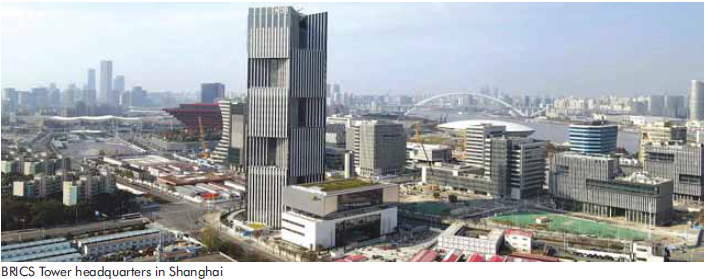
The foreign ministers of the initial four BRIC countries—Brazil, Russia, India, and China—met for the first time in New York City in September 2006 on the sidelines of the General Debate of the UN Assembly. This meeting marked the beginning of a series of high-level diplomatic engagements. A full-scale diplomatic meeting was held in Yekaterinburg, Russia, on June 16, 2009.
The first formal BRIC Summit, also held in Yekaterinburg, took place on June 16, 2009. It was attended by the leaders of the four founding nations: Luis Inácio Lula da Silva (Brazil), Dmitry Medvedev (Russia), Manmohan Singh (India), and Hu Jintao (China). The Summit’s primary focus was improving the global economic situation and reforming financial institutions. The discussions also explored ways for the four countries to enhance cooperation in addressing global challenges and increasing the involvement of developing nations—like three-quarters of the BRIC members—in global affairs.
Following the Yekaterinburg Summit, the BRIC nations announced the necessity of establishing a new global reserve currency characterised by diversity, stability, and predictability. Although their statement did not explicitly criticise the perceived “dominance” of the US dollar—an issue Russia had raised in the past—it did trigger a decline in the dollar’s value against other major currencies.
Expansion in 2010
In 2010, South Africa initiated efforts to join the BRIC grouping. The formal admission process began in August of that year. On December 24, 2010, South Africa officially became a member after being formally invited by China and subsequently accepted by the other BRIC nations. The group was renamed BRICS, with the “S” representing South Africa, to reflect the expanded membership. In April 2011, South African President Jacob Zuma attended the BRICS Summit in Sanya, China, as a full member for the first time.
New Development Bank
In June 2012, the BRICS nations pledged $75 billion to increase the lending capacity of the International Monetary Fund (IMF). However, this contribution was contingent upon IMF voting reforms.
By March 2013, during the fifth BRICS Summit held in Durban, South Africa, member countries agreed to establish a global financial institution as an alternative to the Western-dominated IMF and World Bank. This initiative was the foundation of the New Development Bank (NDB), with plans for its formal establishment by 2014.
During a BRICS leaders’ meeting in St. Petersburg in September 2013, financial commitments toward the reserve pool were announced: China pledged $41 billion; Brazil, India, and Russia each committed $18 billion, and South Africa contributed $5 billion. As China held the world’s largest foreign exchange reserves, it sought a more significant managerial role and proposed hosting the reserve fund.
In October 2013, Russian Finance Minister Anton Siluanov confirmed that $100 billion would be designated to stabilise currency markets, with implementation targeted for early 2014. Brazilian Finance Minister Guido Mantega further confirmed that the fund would be operational by March 2014. However, by April 2014, the currency reserve pool and the Development Bank were delayed, with the timeline pushed to 2015.
In July 2014, during the sixth BRICS Summit in Fortaleza, Brazil, the BRICS members officially signed agreements to establish the $100 billion New Development Bank (formerly referred to as the “BRICS Development Bank”) and a reserve currency pool worth an additional $100 billion. Other agreements included cooperation frameworks between BRICS export credit agencies and collaborative innovation strategies.
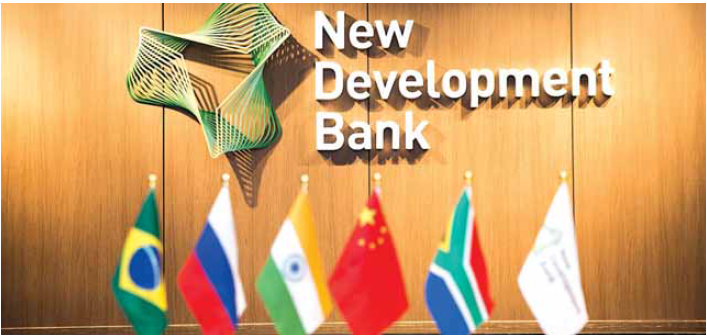
The Fortaleza Summit was followed by a meeting in Brasília between BRICS leaders and the Union of South American Nations (UNASUR) presidents, further solidifying cooperation between the two groups.
A Range of Initiatives
Since 2011, the National Institutes of Statistics of the BRICS nations—comprising IBGE (Brazil), Rosstat (Russia), the National Bureau of Statistics of China, the Central Statistics Office of India, and Statistics South Africa—have collaborated on an annual joint statistical publication. This initiative aims to provide a unified data platform, offering statistical comparisons, insights into adopted methodologies and results beneficial to all participating countries.
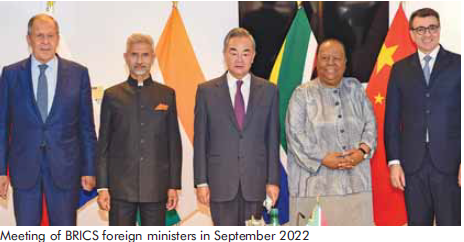
In 2012, BRICS began planning an optical fibre submarine communications cable system, referred to as the BRICS Cable, to facilitate secure telecommunications between member countries. This project was partly motivated by concerns over surveillance by the U.S. National Security Agency, which monitored global telecommunications traffic flowing through the United States. However, as of 2023, the construction of this cable system had yet to commence.
In August 2019, during the fifth meeting of BRICS communication ministers in Brasília, Brazil, a letter of intent was signed to enhance cooperation in the Information and Communication Technology (ICT) sector. This agreement underscored the Group’s commitment to advancing technological collaboration.
The New Development Bank (NDB), a key BRICS institution, announced plans to disburse $15 billion to member states to support struggling economies after the COVID-19 pandemic. The 2020 BRICS Summit, held virtually in St. Petersburg, Russia, focused on addressing the pandemic’s impact and reforming the multilateral system.
At the 13th BRICS Summit in 2021, Indian Prime Minister Narendra Modi called for a transparent investigation into the origins of COVID-19, urging full cooperation from all nations under the World Health Organisation (WHO). In response, Chinese President Xi Jinping emphasised the need for BRICS nations to oppose the politicisation of the investigation process.
In May 2023, South Africa announced plans to grant diplomatic immunity to Russian President Vladimir Putin and other officials, allowing them to attend the 15th BRICS Summit despite the International Criminal Court (ICC) arrest warrant against Putin. However, in July 2023, Putin confirmed that he would not personally attend the Johannesburg Summit, held from August 22 to 24. Instead. He participated remotely, delivering remarks and joining all BRICS leaders’ sessions, including the Business Forum, through virtual channels.
2024 Expansion
At the 15th BRICS Summit in August 2023, South African President Cyril Ramaphosa announced the invitation of six emerging market countries—Argentina, Egypt, Ethiopia, Iran, Saudi Arabia, and the United Arab Emirates (UAE)—to join the bloc. Full membership for these nations was initially scheduled to commence on January 1, 2024.
However, political developments in Argentina disrupted its anticipated membership. Following the November 2023 general election, Argentina’s new President, Javier Milei, pledged to withdraw the country’s application. On November 30, 2023, incoming Foreign Minister Diana Mondino confirmed Argentina’s decision not to join BRICS. By December 29, 2023, the Argentine government formally communicated its withdrawal from the application process to all BRICS leaders.
Saudi Arabia also delayed its entry into BRICS. While initially slated to join on January 1, 2024, the country announced in mid-January that it was still evaluating its decision. As of April 2024, Saudi Arabia’s membership remained under consideration.
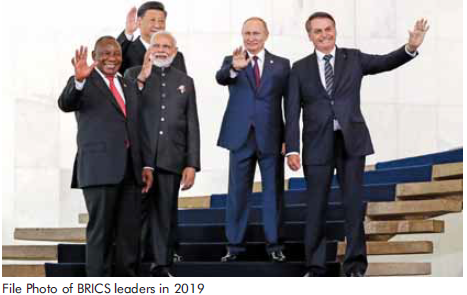
The BRICS expansion was framed as a strategic move to foster a multipolar global order, counterbalancing the Western-dominated geopolitical landscape. China Daily highlighted the expansion as evidence of increasing interest from developing nations in joining BRICS.
On October 24, 2024, the Bloc extended invitations to 13 additional countries—Algeria, Belarus, Bolivia, Cuba, Indonesia, Kazakhstan, Malaysia, Nigeria, Thailand, Turkey, Uganda, Uzbekistan, and Vietnam—to participate as “observer partner countries.” While these nations were not granted full membership, their observer status allows them limited engagement and support from BRICS member States.
Currently, the economic and political dynamics of the Bloc are significantly influenced by China, which contributes approximately 70% of the organisation’s total GDP. Among the member countries, Brazil, India, and China are notable for their inclusion in the world’s top ten nations by population, land area, and gross domestic product (GDP) in both nominal and purchasing power parity (PPP) terms.
As of 2024, all five founding members of BRICS—Brazil, Russia, India, China, and South Africa—are also members of the G20. Together, they represent a combined nominal GDP of US$28 trillion (27% of the global gross world product), a total GDP (PPP) of approximately US$65 trillion (35% of global GDP PPP), and combined foreign reserves estimated at US$5.2 trillion.
BRICS Summits
Since 2009, BRICS has held annual summits, with each member country taking turns to host. Before South Africa’s admission, two BRIC summits took place in 2009 and 2010.
The First Summit with all five BRICS members was held in 2011 in China, marking the expanded group’s formal meeting.
The First Summit with all nine member countries occurred in 2024 in Russia.
Due to the COVID-19 pandemic, the 2020, 2021, and 2022 Summits were conducted via video conference, adapting to the global health crisis.

Is This the End of Dollar Dominance?
At the Kazan Summit, Russia made a concerted push for the creation of a new payment system, aiming to provide an alternative to the global bank messaging network SWIFT. This proposal is part of Moscow’s strategy to circumvent Western sanctions imposed in response to its war in Ukraine.
Russian President Vladimir Putin envisions BRICS—recently expanded to include Egypt, Ethiopia, Iran, and the United Arab Emirates alongside Brazil, Russia, India, China, and South Africa—as a powerful counterweight to Western influence in global politics and trade. A cornerstone of this vision is an alternative international payment platform, designed to shield participating nations from Western sanctions and reduce reliance on the US dollar.
The Kazan Summit, held from October 22 to 24, 2024, was presented by Moscow as evidence that Western attempts to isolate Russia have failed. Central to Russia’s agenda was its call for overhauling the global financial system to diminish the dominance of the dollar.
Central to this initiative is a proposal for a new payment system based on a network of commercial banks linked through the BRICS central banks, as outlined in a document prepared by Russia’s finance ministry and central bank, and distributed to journalists ahead of the Summit.
The proposed system would leverage blockchain technology to store and transfer digital tokens backed by national currencies. This framework would enable these currencies to be exchanged securely and efficiently, bypassing the need for transactions in U.S. dollars.
Russia views this proposal as a solution to its growing challenges in settling trade payments, even with friendly nations like China, where local banks are wary of potential secondary sanctions imposed by the United States.
One specific mechanism under discussion is the BRICS Cross-Border Payment System, designed to facilitate trade in local currencies. This shift is partially driven by perceptions of increasing risks associated with the U.S. dollar. However, the focus on local currencies is not solely about de-dollarisation but also about achieving cheaper and more efficient transactions.

For Russia, cut off from the Society for Worldwide Interbank Financial Telecommunications (SWIFT), this represents a financial lifeline. For Egypt, it offers a way to alleviate pressure on foreign reserves. Meanwhile, South Africa, Brazil, and India are adopting a more cautious approach, favouring diversification without fully divesting from the dollar.

Russian President Vladimir Putin, who presided over the closing session of the BRICS Summit, lauded the Bloc’s role in countering Western policies. He emphasised the need for a new payment system to bypass sanctions, aiming to counterbalance what he referred to as the West’s “perverse methods.”
Putin accused the West of attempting to suppress the rising power of the Global South through illegal unilateral sanctions, blatant protectionism, manipulation of currency and stock markets, and persistent foreign influence, all under the guise of promoting democracy, human rights, and the climate change agenda.
“Such perverse methods and approaches – to put it bluntly – lead to the emergence of new conflicts and the exacerbation of existing disputes,” Putin stated.
However, Yaroslav Lissovolik, founder of the BRICS+ Analytics think tank, noted that while the creation of such a system is technically feasible, it would take time. “After the significant expansion of BRICS membership last year, achieving consensus has arguably become more challenging,” he remarked.
The Russian document accuses existing institutions, such as the International Monetary Fund (IMF), of primarily serving the interests of Western countries and argues that these institutions need reforms to reflect the evolving global economy better. Russian Finance Minister Anton Siluanov recently urged BRICS members to establish an alternative to the IMF.

In addition to proposals aimed at facilitating trade and investment, Russia has put forward the idea of creating a ‘BRICS Clear’ platform to facilitate trade in securities. The document also calls for improved communication between credit rating agencies in BRICS countries, alongside the development of a common rating methodology. However, it stopped short of advocating the establishment of a joint BRICS rating agency, an idea that the Group had previously discussed.
A BRICS Grain Exchange
As the world’s top wheat exporter, Russia is also advocating for the creation of a BRICS grain trading exchange, supported by a pricing agency, to serve as an alternative to Western exchanges that currently set international agricultural commodity prices. Russia’s multifaceted initiatives underscore its determination to challenge Western dominance in global finance and trade. Whether these proposals gain traction depends on the ability of BRICS nations to navigate technical, political, and logistical hurdles. While the path to implementation may be fraught with challenges, the discussions signal a shift in the global economic order and the waning supremacy of the US dollar.
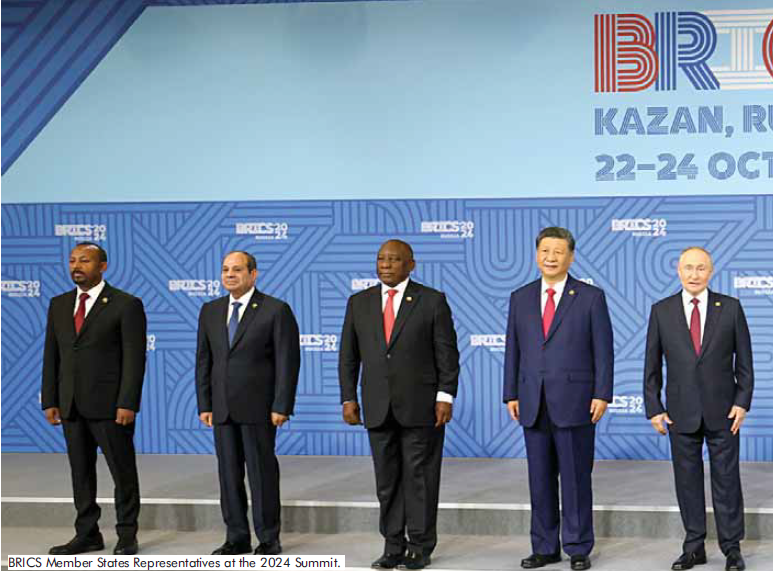
Cover Story16th BRICS Summit Strengthening Multilateralism for Fair Global Development and SecurityCover Story
The 16th BRICS Summit in Kazan, Russia, marked a transformative moment in the evolution of the Bloc, solidifying its role as a crucial platform for the Global South in addressing global challenges. As an inclusive multilateral forum open to emerging markets and developing countries, BRICS has positioned itself as a champion of international cooperation and sustainable development. With its continued growth and influence, the Bloc raises significant questions for the West about the keys to its success. For those seeking answers, the 2024 BRICS Summit offered many insights, writes Ivor Vaz.
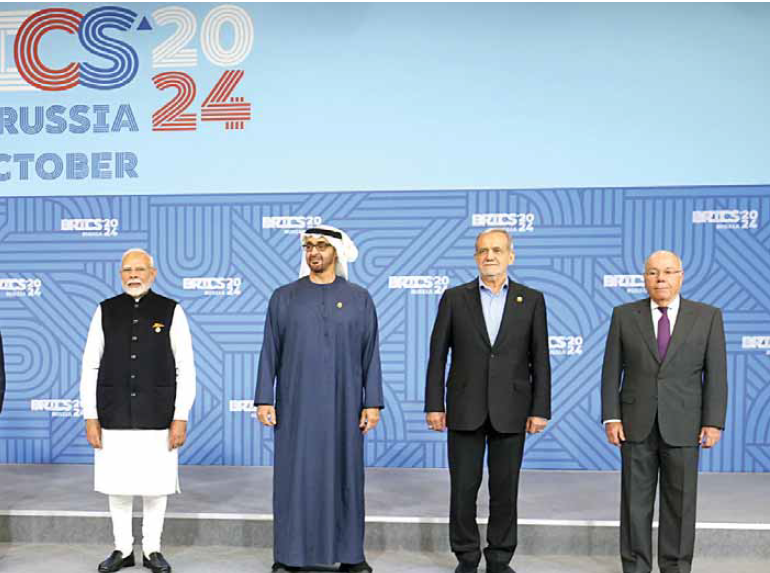
The 16th annual BRICS Summit, held from October 22-24, 2024, in Kazan, Russia, was the first to feature Egypt, Ethiopia, Iran, and the United Arab Emirates as members following their accession at the 15th Summit. The theme, Strengthening Multilateralism for Fair Global Development and Security, underscored the Bloc’s commitment to a more equitable global system.
Strengthening Russia’s Global Presence
Patryk Kugiel, Chief Analyst at the Asia-Pacific Programme of the Polish Institute of International Affairs, highlighted the Summit’s role in reshaping perceptions of Russia. “The worst mistake the West can make is to dismiss the Summit as mere theatre,” he warned, emphasising its diplomatic and strategic significance.
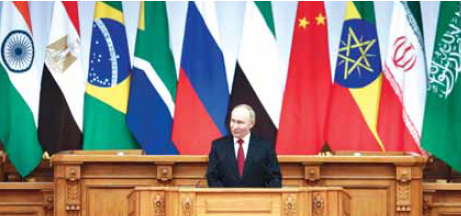
Says Kugiel: “The Summit was historic for two main reasons. First, as expected, it provided an easy diplomatic victory for Vladimir Putin. The Russian President demonstrated that he has not been isolated, trading an extra seat at the Group of Seven (G7) for a central role in the ‘B9,’ and potentially in an expanded ‘B-more’ in the future. Moreover, by advancing discussions on prioritising transactions in national currencies, he further loosened the grip of sanctions. He also positioned himself as a mediator by facilitating talks between the leaders of China and India for the first time in five years.”

“Secondly, and more importantly, it marked the first expansion of the Group since South Africa joined in 2010. Not only did the Summit add four new members, but over 30 countries reportedly expressed interest in future membership. Additionally, 13 States have already been admitted to the newly created category of partner countries. While expansion may amplify internal differences with potentially negative implications for cohesion, it also underscores the growing appeal of BRICS in the Global South,” he added.
Fyodor Lukyanov, Chair of the Council on Foreign and Defence Policy (Russia), echoed these sentiments, “The 2024 BRICS Summit demonstrated that Russia’s isolation is a Western construct. The rest of the world sees little value in joining the policy of pressuring Russia, irrespective of their stance on specific Russian actions.”
Milestones and Innovations
The Kazan Summit introduced significant developments that could reshape global economic and political landscapes. The Summit formally welcomed the new BRICS members: Egypt, Ethiopia, Iran, and the United Arab Emirates (UAE). Notably, Argentina, expected to join, opted out in late 2023 due to a policy shift under President Javier Milei, reflecting a significant geopolitical development in Latin America, while Saudi Arabia is still considering its formal invitation.
Meanwhile, Miguel Díaz-Canel, the President of Cuba, was invited to the Summit but remained in Cuba due to the 2024 blackout. Aleksandar Vučić, the President of Serbia, could not attend because of a conflicting visit from European Union representatives to Serbia. Cuba and Serbia sent representatives to the Summit.
A core focus of the 2024 Summit was modernising security and economic cooperation, with key discussions ranging from counterterrorism to carbon-unit trading. The Summit also addressed critical security challenges, including cybersecurity, terrorism, and regional stability. Historically, the BRICS have been more successful in opposing Western dominance in global governance structures than in articulating a clear, cohesive vision for reform. The increased diversity within the expanded BRICS Bloc could complicate efforts to achieve unified policy positions, particularly in multilateral forums such as the Group of Twenty (G20).
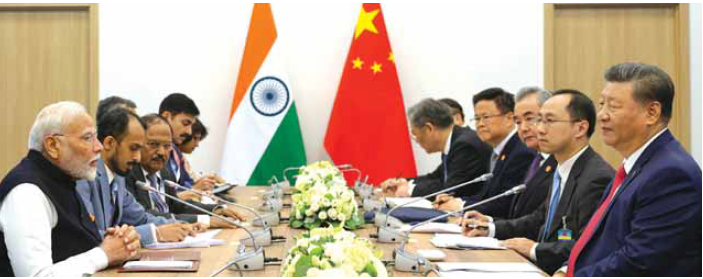
While the Organisation of the Petroleum Exporting Countries Plus (OPEC+) will continue to manage the international oil market, the expanded BRICS energy profile could influence the sector in the long term. Including the UAE and Iran significantly boosts the BRICS energy profile, and if Saudi Arabia formally accepts BRICS membership, the Bloc will represent 42% of the global oil supply. The presence of major oil exporters alongside key importers, China and India—both of which did not favour Western sanctions on Russia—highlights the Bloc’s potential to establish alternative trade mechanisms that bypass the dominance of the U.S. dollar and the financial influence of the Group of Seven (G7).
Key Outcomes
During the Summit, BRICS members introduced a revolutionary payment system named BRICS Pay, designed to streamline transactions and enable the exchange of financial information between the central banks of member nations. This system is an alternative to the Western interbank system SWIFT, facilitating smoother and more autonomous international settlements.
The BRICS Kazan Declaration was officially adopted, signalling a unified commitment to significant global reforms. BRICS nations emphasised the need to reform the United Nations and its Security Council, advocating for the full participation of the State of Palestine in the UN, contingent upon achieving a two-state solution. Additionally, BRICS nations agreed to explore the feasibility of establishing an autonomous cross-border settlement and depository system. To this end, finance ministers will continue evaluating the utilisation of national currencies, innovative payment tools, and alternative platforms, with a detailed report expected during the forthcoming Presidency.
On October 24, Russia hosted a plenary session of the 16th BRICS Summit in the BRICS Plus/Outreach format. This gathering brought together leaders from the Commonwealth of Independent States (CIS), delegations from Asian, African, Middle Eastern, and Latin American nations, and heads of multiple international organisations, underscoring the Bloc’s expansive and inclusive approach.

In a significant step towards broader collaboration, 13 nations have been welcomed as BRICS partner countries. These include Algeria, Belarus, Bolivia, Cuba, Indonesia, Kazakhstan, Malaysia, Nigeria, Thailand, Turkey, Uganda, Uzbekistan, and Vietnam. This expansion highlights the growing appeal of BRICS as a platform for fostering global cooperation and addressing shared challenges across diverse regions.
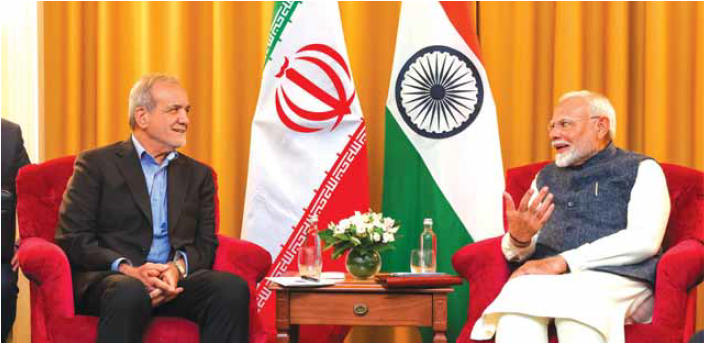
Bilateral Dialogues: Deepening Partnerships
A series of high-level bilateral meetings during the Summit highlighted the Bloc’s role in fostering collaboration:
• China-Russia Cooperation
Chinese President Xi Jinping and Russian President Vladimir Putin held a bilateral meeting in Kazan, reaffirming the strength of China–Russia relations. Both leaders described their partnership as profound and resilient, even amidst turbulent geopolitical conditions. They emphasised the importance of advancing the comprehensive integration of the Belt and Road Initiative with the Eurasian Economic Union, a move aimed at facilitating and bolstering the high-quality development of their economies.
In anticipation of the 80th anniversary of the establishment of the United Nations and the victory in World War II in 2025, China and Russia agreed to deepen their comprehensive strategic cooperation. They pledged to uphold the international system centred on the United Nations.
The leaders also articulated a shared vision for enhancing the BRICS cooperation framework, to achieve what they termed “Greater BRICS Cooperation.”
Russia expressed interest in developing an alternative international payment solution within the BRICS framework to reduce dependence on traditional Western financial structures and mitigate the impact of U.S. secondary sanctions.
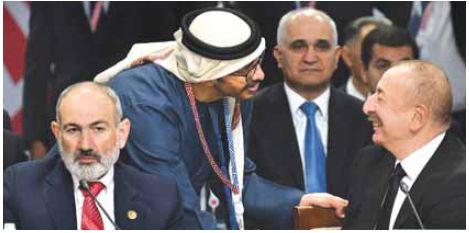
• India-China Rapprochement
Indian Prime Minister Narendra Modi and Chinese President Xi Jinping held their first formal bilateral meeting in five years, following the deadly military clash between the two nations in 2020. The leaders announced they had agreed to resolve the four-year-long standoff, including the complete disengagement of troops. President Xi underscored the significance of the two ancient civilisations in the Global South, asserting that a stable and cooperative India-China relationship could serve as a model for other emerging nations.
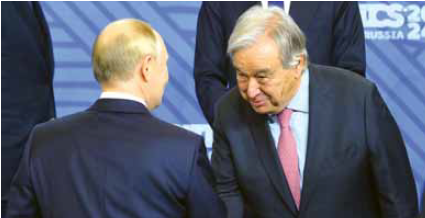
Prime Minister Modi highlighted that maintaining steady progress in India–China relations is essential for the welfare and future of their combined 2.8 billion people. He noted that this stability is vital for their respective populations and for fostering regional and global peace and stability. Both nations agreed to approach their relationship with a strategic and long-term perspective. They stressed the importance of preventing isolated issues from adversely impacting their broader ties.
• India-Iran Partnership:
Discussions between PM Modi and Iranian President Masoud Pezeshkian focused on strengthening trade and connectivity through the Chabahar Port and the International North-South Transport Corridor. They also addressed regional stability and the Israeli-Palestinian conflict.
President Pezeshkian accepted the invitation from PM Modi to visit India.
• Russia-South Africa Alignment:
South African President Cyril Ramaphosa held a bilateral meeting with Russian President Vladimir and reaffirmed Russia’s role as a “valued ally,” citing its support during the apartheid era.
Indian Prime Minister Narendra Modi and South African President Cyril Ramaphosa opted to attend the BRICS Summit over the 2024 Commonwealth Heads of Government Meeting (CHOGM), which took place in Samoa during the same week. The Independent noted that this decision highlights the prioritisation by these two Commonwealth nations of strengthening ties with China and Russia over the broader, yet less focused, agenda of CHOGM.

Enforcing POCSO Act 2012: The Vital Role of Police in Protecting Children
Satya Gopal Dey is a Member of the West Bengal Task Force on combating human trafficking; a Member of the Selection Committee of CWC and JJB, Government of West Bengal, and the Head of Child Protection, Advocacy and HR at Vikramshila Education Resource Society.
The police serve as the public face of the State, and the way the State treats its citizens, particularly children, will significantly impact the success of the POCSO Act 2012 in realising its transformative vision. This vision seeks to shift societal perceptions, recognising children as autonomous beings with rights, rather than merely dependents in need of protection.
The law aims to address historical challenges while envisioning a redefined relationship between children and the police.
The POCSO Act 2012 establishes comprehensive guidelines and procedures designed to transform the interaction between police and child victims. It also includes stringent provisions to ensure accountability and uphold the rights of children.
Child-Friendly Procedures for Police
Free Copy of FIR: A copy of the FIR must beprovided free of cost to the complainant or the parent/guardian if they have made the complaint.
Right to Legal Assistance: The child, their guardian, parent, or a trusted person must be informed of the child’s right to be assisted and represented by a lawyer of their choice (Rule 4(2)(f)). This right applies from the time of making a statement to the police until the conclusion of the case.

Access to Support Services: Police must inform the child and their family about available support services, such as counselling, as per Rule 4(2), and assist them in accessing these services if needed or requested.
Simplified FIR: The FIR must be written in simple language that the child can understand (Section 19(3)).
Provision of Translator: If the FIR is recorded in a language the child does not understand, a translator must be provided to explain its contents to the child (Section 19(4)).
Comfortable Environment for Statements: The child’s statement should be recorded either at their residence or another place where the child feels comfortable. This should occur in the presence of someone the child trusts, usually a parent or guardian (Section 24).
Accountability of Police and Rights of the Child Victim
When an SJPU (Special Juvenile Police Unit) or the local police receives information under subsection (1) of Section 19 of the Act from any person, including the child, they are required to immediately disclose the following details to the person providing the information: their name and designation, their address and telephone number, and the name, designation, and contact details of the supervising officer overseeing the officer receiving the information.
The police play a pivotal role in ensuring the safety, protection, and justice for children, particularly in cases involving offences under the law. This includes duties performed by the Special Juvenile Police Unit (SJPU) or local police, as mandated by the provisions of sub-section (1) of Section 19 of the Act.
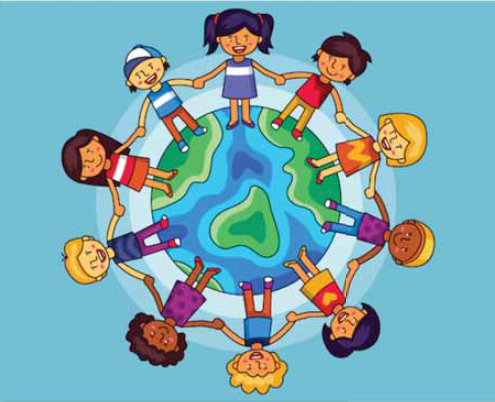
When an offence is committed, attempted, or is likely to be committed, the concerned authority must take immediate and appropriate actions, including:
Filing and Registering an FIR: The police must proceed to record and register a First Information Report (FIR) as per the provisions of the Bharatiya Naya Sanhita. A copy of the FIR must be furnished free of cost to the person making the report.
Arranging Emergency Medical Care: If the child requires emergency medical care as per sub-section (5) of Section 19 of the Act or under the relevant rules, the police must arrange for the child to access such care, under Rule 5. This includes taking the child to the hospital for a medical examination, as specified under Section 27 of the Act.

Forensic Evidence Collection: The investigating officer must ensure that samples collected for forensic tests are sent to the forensic laboratory at the earliest to avoid delays in the investigation process.
Providing Information and Support Services: The police must inform the child, its parents, guardian, or another trusted person, about the availability of support services, including counselling. They must also assist them in contacting the individuals or organisations responsible for providing these services and relief.
Legal Rights and Representation: The police must inform the child and their parent, guardian, or trusted person about the child’s right to legal advice and counsel. Additionally, they must ensure the child’s right to be represented by a lawyer, as per Section 40 of the Act.
During the investigation of an offence involving rape or an attempt to commit rape, if it is necessary to have the survivor examined by a medical expert. The following steps must be taken:
The examination must be conducted by a registered medical practitioner employed in a government or local authority hospital.
If a specific practitioner is unavailable, any other registered medical practitioner may conduct the examination, provided that the survivor or a person authorised to provide consent on her behalf grants permission.
Additionally, the survivor must be taken to the medical practitioner within 24 hours of receiving information about the offence.
Upon receiving information under Section 19 of the Act that an offence has been committed against a child, an officer of the SJPU or local police must determine whether the child urgently requires medical care and protection. If so, they are required to arrange for the child to be taken to the nearest hospital or medical care facility for emergency medical attention within 24 hours. If an offence has been committed under Sections 3, 5, 7, or 9 of the Act, the victim shall be referred for emergency medical care.
Emergency Medical Care: Emergency medical care shall be rendered in a manner that protects the privacy of the child and in the presence of the parents, guardian, or any other person the child trusts.
No Documentation Required: No medical practitioner, hospital, or medical facility offering emergency medical care to a child shall demand legal or magisterial requisitions or any other documentation as a prerequisite to providing care. By fulfilling these responsibilities, the police uphold the principles of child protection, ensuring that the child’s best interests are safeguarded by the law. This systematic and sensitive approach not only seeks justice for the victim but also prioritises the child’s well-being throughout the legal process